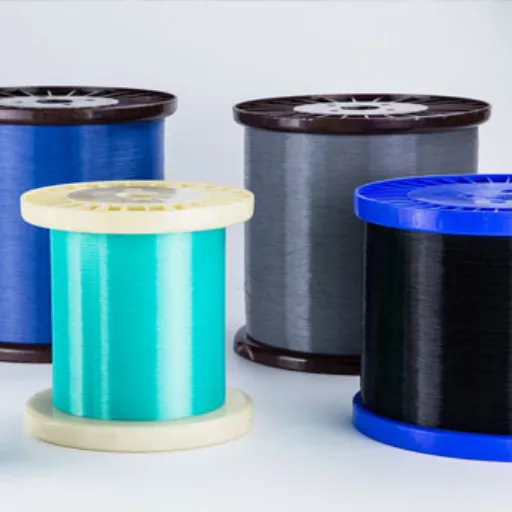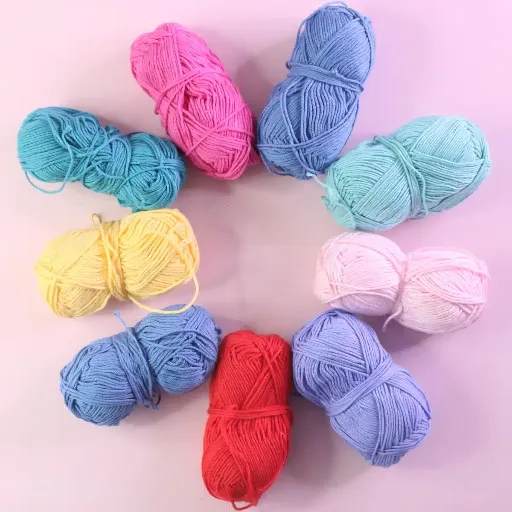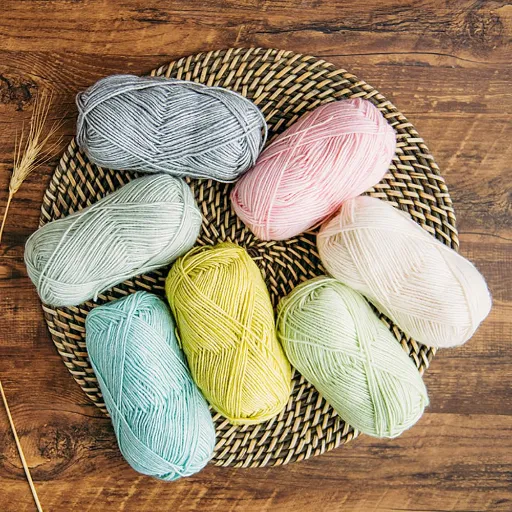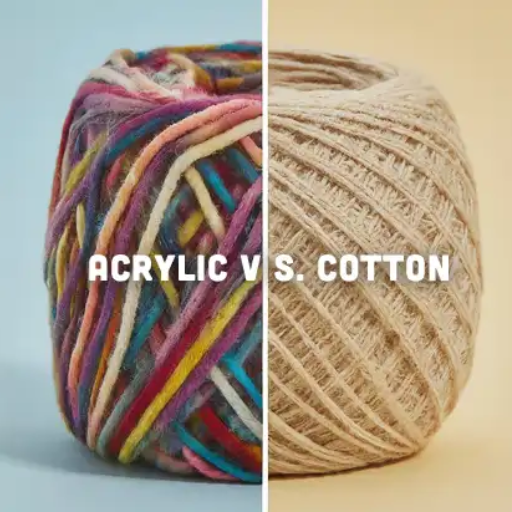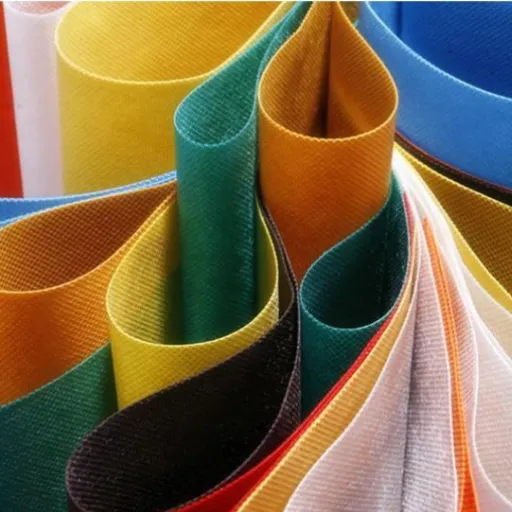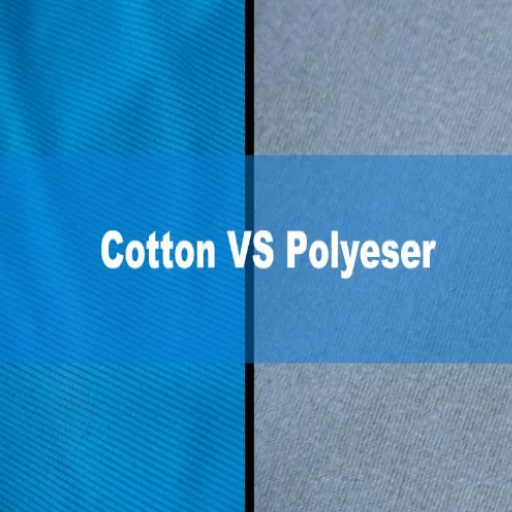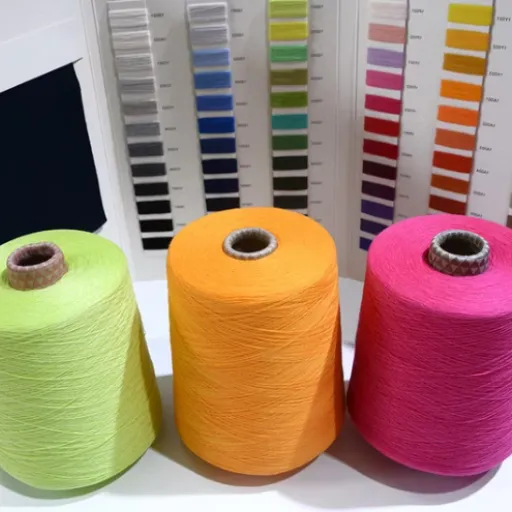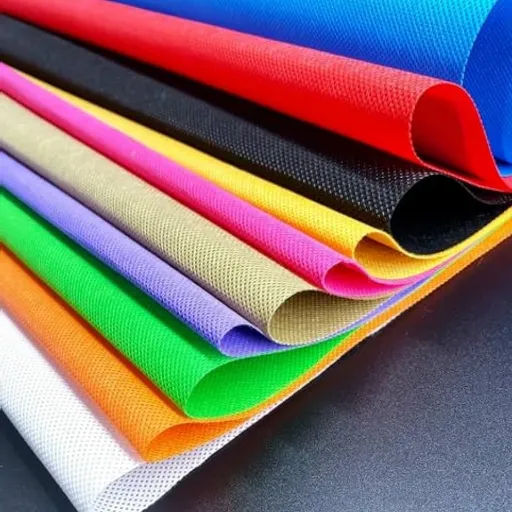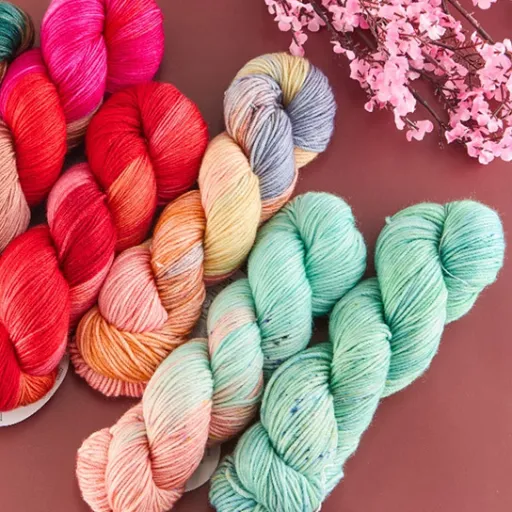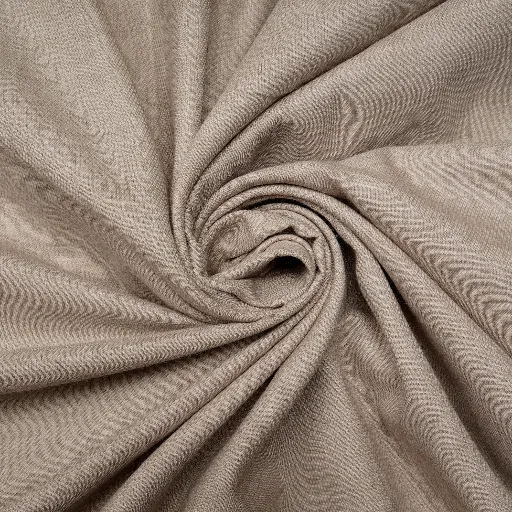Selecting the proper yarn for your project can be quite a daunting task, particularly if you are dealing with synthetic fibers like acrylic and polyester. The two materials are extensively used in the arts and crafts, and their differences can affect the look, texture, and longevity of your projects. This guide will take you through the main differences between acrylic and polyester yarn and help you to choose the one that best suits your needs, tastes, and circumstances. If you want to know about cost-effectiveness, versatility, or certain fabric characteristics, this article will provide you with the information to select the right yarn for any project. Keep reading as we discover the advantages, disadvantages, and uses of these synthetic fibers that have gained such popularity!
Acrylic Yarn
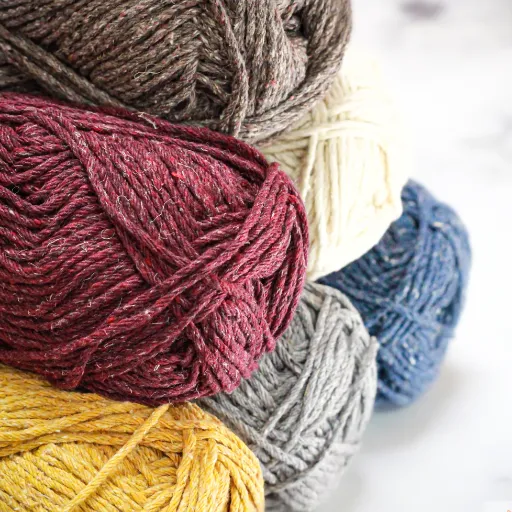
Properties of Acrylic Fibers
Acrylic fibers are synthetic fibers made from polyacrylonitrile, which is a kind of polymer. Due to their excellent durability, they are very popular in the textile industry, along with other properties like softness and lightness. Acrylic is the yarn that can be best regarded for its ability to imitate wool in both touch and appearance while being much cheaper.
Moisture resistance is one of the most important properties of acrylic fibers. Acrylic yarn, unlike natural fibers like cotton or wool, does not absorb water quickly, hence it dries fast and has also resistance to mold and mildew. Moreover, acrylic fibers have resistance to damage by moths which makes them a good choice for projects that are intended for the long term or for storage.
Despite these advantages, acrylic fibers have their own drawbacks too. One of the disadvantages is that they are less breathable than natural fibers, which may lead to discomfort during hot weather. Also, acrylic yarn can create fuzz balls, known as pilling, which may affect the appearance of your finished work to be affected over time. Nevertheless, the same factors that make them drawbacks, the versatility, low price, and easy care, still make acrylic yarn a good choice for many different types of crafts and knitting.
Common Uses of Acrylic Yarn
The main reason behind the widespread use of acrylic yarn in various crafts and projects is its multipurpose nature, strength, and low cost. The following are the most popular usages:
- Clothing and Apparel:Acrylic yarn is often used for the making of sweaters, scarves, hats, gloves, and other clothing items, Its ability to imitate the softness and coziness of natural fibers like wool along with being cheaper makes it a very good option for the production of these kinds of items. Market data points suggest that acrylic yarns contribute to the total sale of synthetic yarn worldwide by around 60%, which is a clear indicator of their textile industry popularity.
- Blankets and Home Decor:Crafters usually select acrylic yarn to crochet or knit blankets, pillow covers, and decorative throws. Its durability and washing ease make it very suitable for home-use products which usually go through the wearing and tearing of regular use. Besides, the availability of a variety of colors is a major factor that contributes to the creativity of home decor through the use of acrylic yarn.
- Amigurumi and Toys:The no. 1 option for amigurumi creations is acrylic yarn — the very popular Japanese art of crocheting or knitting small stuffed animals and figures. Acrylic is light, keeps its shape nicely, and is less liable to damage which makes it perfect for making intricate toys. Recently, there has been an increasing demand for handmade toys which in turn has given rise to the trend of using acrylic yarn for such projects.
- Accessories and Bags:Bags, totes, and other accessories usually rely on acrylic yarn because of its strength and cost-effectiveness. Some structured items, such as purses, gain from the rigidity of acrylic over that of natural fibres especially when reinforced by tight stitching which is a common technique for handbags.
- Crafts for Beginners:Acrylic yarn is widely recognized as a beginner-friendly material for those who are learning to knit or crochet. Its low price and soft texture make it possible to practice stitches without worrying about ruining expensive yarn. According to some online craft stores, acrylic is the primary material in more than 70% of the beginner-level yarn kits which may be due to its affordability and ease of handling.
- Seasonal and Outdoor Items:Pursuits related to holidays, such as decorations, garden exhibitions, and outdoor installations, often use acrylic yarn as the main thread owing to its property of being less likely to fade from the sun and more tolerant to the harshness of weather than natural fibers.
The versatility and practicality of acrylic yarn have made it an indispensable item in the crafting world. It doesn’t matter if you are making wearable items, home decor, or art projects; acrylic yarn provides a reliable and creative medium to realize your ideas.
Advantages of Acrylic Yarn
- Affordability:One of the main reasons for the widespread use of acrylic yarn is its low cost. It is a very economical option for those who want to create or design something nice without spending lots of money. Sometimes, acrylic yarn is so much cheaper than the natural fibers, such as cotton or wool, that it still provides the same advantages and functionality. Of late, the market has been flooded with affordable acrylic yarn, thus contributing to its widespread acceptance in both DIY and industrial uses.
- Durability:Acrylic yarn is very durable and can still be used regularly. Blankets, hats, and clothing will be the most common items made with this yarn since these items will be washed or used frequently. Recent scientific research says that when subjected to similar kinds of environmental strains, the acrylic yarn retains its form for a longer time as compared to some natural fibers.
- Ease of Maintenance:Acrylic fiber is different from fleece and cotton in that it is a machine-washable yarn so it will not shrink easily. Over 70% of today’s consumers still prefer easy-care fabrics for everyday items, and acrylic yarn is the perfect match for these consumers.
- Color Variety and Retention:Acrylic yarns have an almost unlimited range of colors that are very lively and bright, and thus they give one plenty of options for a creative project. The manmade material also allows the yarn to keep its original color over a long period. Fading has been pointed out by the experts as a common problem with natural fibers, but among all such yarns, acrylic would still be at the top as it has greater resistance to fading even when exposed to sunlight for a long time.
- Lightweight and Softness:Acrylic yarn doesn’t weigh at all but can still imitate the softness of the expensive natural fibers like wool. The latest technologies in the production of acrylic yarn have resulted in even softer and more comfortable acrylic options; these are the ones that can be safely used by sensitive skin and made into lightweight garments.
- Hypoallergenic Properties:If anyone is allergic to animal-based fibers, then they can use acrylic yarn as a very good alternative. It would give all the warmth and usability that the wool would have given but without causing any allergy which is really important for baby clothes or bedding.
All these reasons make it very clear why acrylic yarn keeps being the material of choice for both hobbyists and commercial designers. The combination of the low price, the wide range of uses, and the ease of care is such that this synthetic fiber will never go extinct in the crafting community.
Polyester Yarn
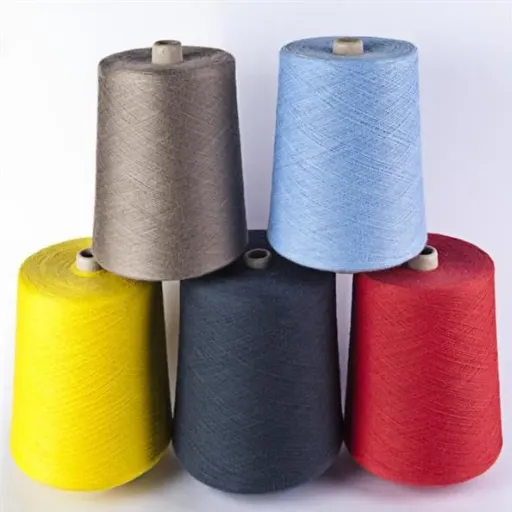
The main features of polyester fibers
Polyester fibers are generally recognized for their robustness, flexibility, and resistance to abrasion. These man-made fibers are very strong and can easily bear a lot of tension without breaking, which makes them perfect for numerous uses. Furthermore, polyester is also quite flexible, so no matter how much it is stretched or shrunk, it will not lose its original shape easily.
The moisture and power of the stains are the highlights of polyester. The fibers have a hydrophobic property which means that they do not absorb water; hence, they are quick to dry, unlike their natural counterparts. This is a major plus for outdoor and sportswear fabrics, where polyester is the main fabric due to its non-absorbing nature and lightweight. To add on, the staining resistance of polyester fibers makes them more practical since it is easier to clean spills and dirt.
Furthermore, polyester fibers are also very durable against environmental factors like sunlight and mildew. Polyester, unlike some natural fibers, resistant to UV light decay and thus its use in upholstery, curtains, and outdoors, etc., is expanded to such places. Also, its ability to resist mildew and mold ensures its longevity in damp conditions. These qualities, coupled with low price and easy maintenance, make polyester a preferred material in both arts and industrial uses.
Applications of Polyester Yarn
The very distinctive features of polyester yarn, such as its strength, stretching capability, and affordability, make it a preferred choice across different industries. A few of the main sectors where the use of polyester yarn is prevalent are listed below:
- Textile Industry:Polyester yarn is the primary component for the entire range of textile products that come under the category of clothing, which includes sportswear, outerwear, and underwear. Also, the nature of the polyester fabric being lightweight, wrinkle-free, and quick-drying, suitable for the making of versatile clothing.
- Home Furnishings:Polyester yarn is used in products like curtains, rugs, upholstery, and bed linens because of its strength, resistance to fading from UV exposure, and easy cleaning. Its use in home textiles has been on the rise and, in recent years, it has captured over 40% of the global market share of home furnishing fabrics.
- Industrial Applications:Polyester yarn finds wide acceptance in the industrial domain, where it is used in the manufacture of conveyor belts, tarpaulins, safety belts, nets, and ropes. It is made possible to be a strong and reliable raw material thanks to its high tensile strength and environmental stress resistance. Moreover, the new jersey production techniques have also facilitated the availability of eco-friendly and recyclable polyester yarn, which can be used in the sustainability-oriented industries.
- Automotive Industry:In the automotive sector, polyester yarn is an ingredient of car seat covers, interiors, carpets, and airbags, among others. Its strength and wear-resistance are the two main reasons that it is always picked for vehicle applications.
- Sports Equipment:Polyester yarn is essential in the making of nets, parachutes, artificial turf, and outdoor sports gear. Its ability to withstand extreme weather conditions, along with the heat and moisture resistance, ensures the longevity and reliability of sporting products.
- Healthcare Sector:Due to its hypoallergenic and non-absorbent properties, polyester yarn is incorporated into surgical gowns, medical curtains, and wound dressing materials. The global demand for medical textiles made from polyester has increased, particularly as a result of the COVID-19 pandemic and the general increase in hygiene standards.
The diverse applications of polyester yarn, which are backed by data and trends, denote its crucial presence in various sectors and hence, its continuous significance in both daily life and industrial growth.
Benefits of Polyester Yarn
- Durability and Strength:Polyester yarn has the extraordinary capability of being very strong and tough, which it and the other industrial and consumer uses transfer over to long-term use. Its resistance to stretching, contracting, and abrasion ensures that it still exists even when the conditions are very tough.
- Moisture Resistance and Quick Drying:Hydrophobic nature is one of the most considerable benefits that polyester yarn possesses, and it is the reason why it doesn’t absorb water. This characteristic not only helps in drying faster but also, the material an excellent choice for sportswear, outdoor clothing, and upholstery.
- Cost-Effectiveness:The production of polyester yarn is not as expensive as that of natural fibers, thus it is an economical choice for manufacturers and consumers as well. Its production cost, which is lower than that of many other fibers, along with its great availability, is a factor in pushing its application in the textile and other goods markets that are not so costly.
- Recyclability and Environmental Impact:Technological development has made it more possible to recycle polyester yarn than ever before. The recycled polyester commonly known as rPET is produced from the plastic bottles that have been recycled, and it has been in great demand because of the abandoned eco-friendly practices by the industries.
- Versatility:The flexibility of polyester yarn guarantees its use in many different sectors. In addition to, and even more than, the use of textiles and clothing, its applications are extensive in car interiors, building materials, medical products, and home furnishings. The versatility of this material has resulted in the steady, worldwide demand that is further increased by newer innovations that are constantly expanding its range of applications.
All in all, polyester yarn keeps driving the innovation of the Industry, overcoming the challenges of hygiene and environmental protection while meeting important demands across different sectors. It is this impeccable marriage of practicality and affordability that has made it a major player not only in everyday life but also in high-performance industrial applications.
Comparative Analysis: Acrylic vs Polyester
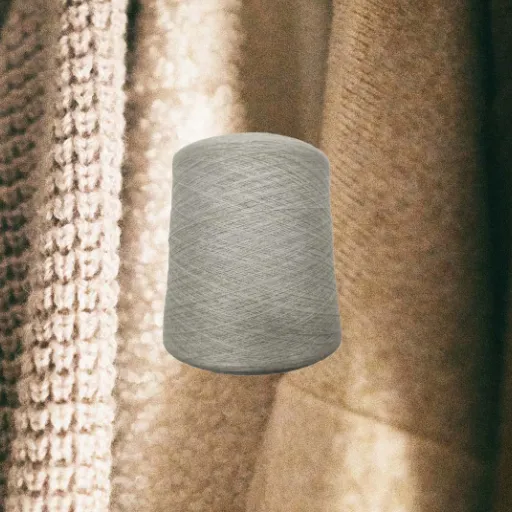
Durability and Longevity
In terms of durability and longevity, both acrylic and polyester have considerable strengths, though the extent of their performance may differ based on the end use application. Polyester is considered the best of the best when it comes to resistance to wear and tear, and it also has the quality of keeping its strength even after a long period of use. That is why it is one of the most common materials used for outdoor and industrial applications where the weather can be quite a factor, as well as in areas with high human traffic.
Acrylic, however, is resistant to all the major environmental factors, such as warping and fading due to UV rays and moisture. To put it another way, it is the one that will not change color or lose its brightness when constantly exposed to the sun, and its rain-repellent property will not turn the application into an unsuitable one where exposure to nature is the rule. Nevertheless, it may not be as tough as polyester in cases that involve very high physical strain or scrubbing in the long run.
To summarize, both materials are very good in their own aspects but their acceptance is limited by the specific use cases. Polyester is the best choice for high-stress situations because of its durability, while acrylic is the preferred material in areas where there is a lot of sunlight and moisture. The decision between the two materials must carefully take into account the factors of the environment and the anticipated degree of wear and tear.
Feel and Comfort
Polyester and acrylic have different feel and comfort characteristics that make them ideal for different purposes. For instance, polyester is a synthetic fiber with a smooth and slightly stiffer texture that can be less soft than natural fibers, especially for people with sensitive skin. But the textile industry has made huge advancements in producing polyesters that feel more comfortable by either blending them with other materials or treating them to enhance their softness. Polyester is now lightweight and breathable, which makes it a perfect choice for activewear and long-lasting everyday fabrics.
On the contrary, acrylic is a synthetic fiber that imitates the warmth and softness of natural fibers, particularly wool. Besides the fact that it has a delightful and comforting feel, the fabric is frequently demanded for clothing such as sweaters, scarves, and blankets. The fibro keeps the body warm and has very soft and comfortable texture, which attracts people who want garments for the cold season. However, sometimes acrylic could be less breathable, thus making it unsuitable for hot or humid areas.
At the end of the day, feel and comfort of polyester vs acrylic are mostly dependent on one’s choice and planned usage. Polyester stands out for durability and moisture-resistant comfort which can be very active scenarios. On the other hand, acrylic gives the feel-good factor and is the warmest option for garments meant for comfort and insulation. Getting to know the differences is useful to make an informed decision based on what is needed and the weather conditions.
Absorbency and Moisture Management
There is a huge difference in the absorbency and moisture management properties of polyester and acrylic. Polyester is a hydrophobic fabric that pushes out water and does not absorb moisture at all. That is to say, it is an excellent wicking agent that absorbs sweat, and skin gets dry which is comfortable during the active or humid conditions. Polyester’s moisture-resistant qualities also enable it to dry rapidly after laundering, which is great for everyday use or sportswear.
On the contrary, acrylic has a higher moisture retention capacity than polyester due to its non-hydrophobic nature. Acrylics are breathable but not as efficient as polyester in terms of moisture-wicking. They give, however, warmth and insulation as a trade-off that makes them more useful in the cold weather clothing where dry is less important than warm. Besides, this moisture retention might work against acrylic in the case of high-intensity activities through aesthetic perspiration difficulty.
The moisture management approach between polyester and acrylic has to be based on the use of the fabrics. Polyester would be the preferred option for activities such as workouts or outdoor adventures where staying dry and comfortable throughout is necessary. On the other hand, acrylic with its warmth fixture would be an excellent choice for cold weather garments insulation where keeping warm is the main concern. So, by knowing these differences, you can easily pick the right fabric for your needs and situations.
Cost Considerations
The cost of polyester and acrylic fabrics has to be looked at both in terms of initial pricing and the long-term worth of the materials. The common notion is that polyester is less pricey than acrylic, but this could change depending on the specific quality and type of polyester product. The material’s widespread adoption along with efficient manufacturing processes, makes it relatively low-cost which is why it is considered to be a cost-effective option for various places and industries.
Normally acrylic is a bit more expensive, but it can still be a good value for money in case of the requirements of high warmth and insulation. This is to some extent true for winter clothes since acrylic imitates the characteristics of wool at a fraction of the cost. On the other hand, acrylic may not be as strong as polyester which can be a factor for the overall cost effectiveness of the material in the long term, depending on the frequency of usage or washing.
The final decision should consider both price and performance needs. If the customer wants a strong and versatile product, polyester would be the better choice. Conversely, for certain warmth-related applications, acrylic might be able to validate its slightly higher price. Weighing these factors will enable you to find the most economical option for your distinct needs.
Environmental Impact of Acrylic and Polyester
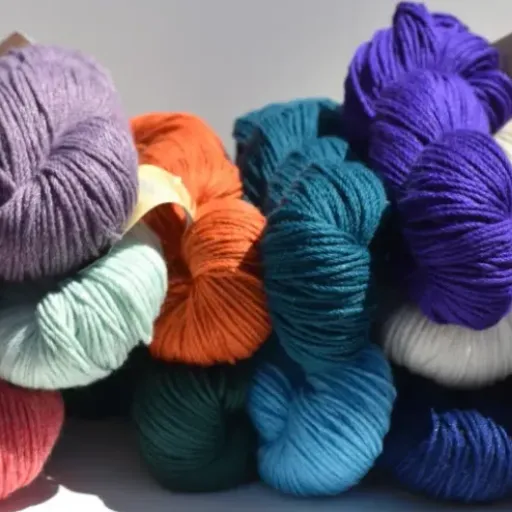
Production Processes and Sustainability
There is no denying that acrylic and polyester production processes have significant environmental footprints, with acrylic being the worst offender. Acrylic fibers are made from acrylonitrile, which is a synthetic compound that is produced by means of the reaction of propylene with ammonia. The entire process of manufacturing acrylic fibers is very energy-dependent, and it also uses several hazardous and toxic chemicals that are detrimental not only to people but also to the environment. In addition, the activities related to acrylic production release greenhouse gases and if not properly controlled, they will also lead to air and water pollution.
Polyester, on the contrary, mainly comes from petroleum-derived products. It goes through a process that calls for the extraction of crude oil, its refining, and conversion into synthetic fibers through polycondensation. All these add up to the process being very energy-demanding, that a lot of CO2 is released, hence speeding up global warming. Moreover, since the basic materials for polyester production are finite resources, it is a non-sustainable option for a long period of time.
Both plastic materials are biodegradable, which is why they remain in the environment for a prolonged period, even decades after they have been disposed of. Nevertheless, polyester is being recycled into brand new fibers at an increasing rate which significantly reduces the amount of waste generated and lowers the energy consumption compared to making new polyester from scratch. The situation of acrylic recycling is not as good since it is limited owing to the complexity of its structure. Ultimately, better recycling technologies and the adoption of eco-friendly manufacturing practices are some of the very important steps towards the reduction of the environmental burden these materials cause.
Usage and Disposal Concerns
Environmental problems are mainly caused by the broad use and disposal of polyester, acrylic, and other synthetic fabrics. These materials are very popular in the clothing, upholstery, and home decoration industries offering durability, low cost, and easy cleaning as their main advantages. However, because they are so durable, the products made from such synthetic fibers usually end up in landfills, where they take a long time to decompose and, while doing so, they emit microplastics into nature. The situation gets worse with improper disposal or incineration; these practices harm the environment and health even more.
Using appropriate disposal methods and boosting recycling activities are essential to limit the environmental impacts of synthetic textiles. Different recycling technologies have been developed and are still being refined, such as mechanical and chemical recycling processes, which aim to decompose these materials for new applications. There have been some advancements in polyester recycling, but the process for acrylic is still quite difficult because of the polymer’s structure. Public education campaigns and more stringent laws concerning the disposal of textile waste can facilitate the acceptance of advanced recycling technologies and teach people how to properly dispose of such waste.
In order to have a lesser impact on the environment, not just one but both consumers and manufacturers can take proactive actions. The latter can make eco-friendly alternatives the priority in their research and development and also support closed-loop recycling systems that prolong the life cycle of materials. The former, however, can get rid of old fabrics in a more environmentally friendly manner by donating or repurposing and by choosing products made of recycled or biodegradable fibers. These combined actions are significant in cutting down the ecological footprint of synthetic textiles and are also a step towards a greener future.
Future of Sustainable Synthetic Fabrics
Sustainable synthetic fabrics of the future will depend on innovations and on the cooperation between the different industries. Researchers are still working hard to come up with new materials that will be made from renewable resources, such as plant-based polymers and bioengineered fibers, to cut down the use of fossil fuels and switch to green energy. Their goals are not only to cut down on carbon dioxide emissions but also to help with the issue of microplastic pollution. A good example would be that many of the new fibers created in this context are eco-friendlier in the sense that they will not only degrade naturally but will also not cause any harm to the ecosystem, thus making a stronger case for a more circular textile economy.
The integration of advanced recycling technologies is another area of promise that will help the planet. These technologies can turn synthetic fabrics back to their core components for reuse. Among the different methods of recycling, chemical recycling stands out as having the ability to reclaim high-quality fibers while still keeping the material unchanged in terms of quality over time. Consequently, such innovations will drastically reduce the amount of clothing dumped in landfills and the need for the virgin material industry to produce new materials will be the same or less. The coupling of the recycling process with an automated sorting system can further make the operations faster as well as more efficient throughout the recycling chain.
The coalition of the production, the legislation, and the consumption sectors is the basic condition for the fast adoption of sustainable practices in the textile industry. Governments can introduce tough standards that will only allow the use of environmentally-friendly production processes, whereas the consumers’ increasing preference for ethics in products will push the producers to shift their practices. Furthermore, public awareness and educational initiatives can tremendously contribute to the establishment of responsible consumption patterns. Uniting these efforts can pave the way for a scenario where synthetic fabrics are not only performant but also eco-friendly, thus contributing to the global sustainability targets.
Choosing Between Acrylic and Polyester
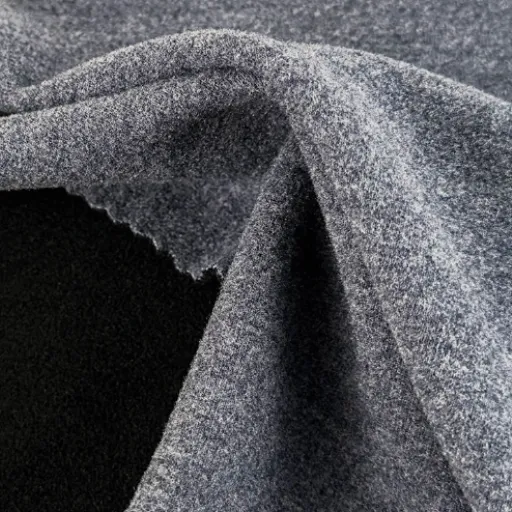
Factors to Consider When Selecting Yarn
- Durability and Longevity:The durability, in particular, is an important factor to consider while selecting yarn for the project that would have the yarn to be used or bear the most wear and tear. The most common arrangement in which acrylic yarn is made with other fibers is where polyester yarn also gets good durability benefits but not at the same level. A very recent survey indicated that the life of most polyester yarn is about 5-10 years; after which it starts degrading. The lifespan of acrylic is even longer as it retains good shape over the years.
- Softness and Texture:The yarn texture is a decisive factor on the comfort of the whole product. Acrylic yarn has developed a lot in the area of softness so that many modern varieties are even claiming to offer a wool-like feel. Thus, soft yarn varieties are perfect for making warm and stylish garments such as sweaters, scarves, and throws. The normal smoothness and shine of polyester yarn make it more appealing for items where a polished look is desired, for example, decorating articles. However, depending on the quality, the polyester might be a little less comfortable on the skin as compared to acrylic.
- Environmental Impact:The environmental impact of yarn production and biodegradability is another consideration that is getting ever more significant. Both acrylic and polyester, being synthetic and thus petroleum-based, are non-biodegradable and contribute to microplastic pollution if they are washed. Nonetheless, polyester is still gradually offering some lure with its eco-friendliness as recycled polyester yarn is becoming more and more common. To put it in another way, companies like REPREVE® and others are progressing by producing yarn using post-consumer plastic bottles, which not only lessens landfill waste but also the usage of virgin materials, according to Google’s data.
- Cost and Accessibility:When we measure the price it usually ends in favor of acrylic. Its widespread availability along with low prices makes it a fantastic choice for large projects or for beginners who are just trying their hand on the art. The case of polyester yarn is a bit different as its price can be slightly over a similar quality acrylic yarn, especially if the source of the material is recycled. This price difference gets wider when it comes to specialty polyester yarns which are meant for specific applications, such as water resistance or UV protection, and are usually the ones used in outdoor projects.
- Versatility in Usage:All the same, acrylic and polyester yarns are very versatile and can accommodate a wide variety of creative projects but the performance differs in some instances. Heat retention is the strong point of acrylic and it is often used for making winter clothing because of that. The drying rate and ability to wick off moisture are the two areas where polyester excels, thus the fabric is suitable for active wear or projects subjected to outdoor environments. The latest reviews give a plus point to acrylic in the area of dyeing as it offers a larger color palette, while polyester is a bit difficult to dye and this often results in it having a limited number of color options.
To get the best of both yarns, weigh these pluses and minuses against the specific needs of your project and you will be able to pick the right one for you. Each material has its own unique use, thus crafters and consumers alike will always be able to find the perfect one for their creative ventures.
Applications Best Suited for Each Material
Cotton is the most appropriate choice for applications that need softness, warmth, and strength at the same time. It is a perfect fabric for t-shirts, socks, and baby clothes, among others, where the priorities are comfort and flexibility. Besides, due to absorbing moisture and regulating temperature it is a natural property, cotton is still the king of home goods such as bedsheets, towels, and curtains which are used for everyday life.
Unlike cotton, polyester has defined its role as a material of choice in .. where the stretching-free as well as of shrinking resistance qualities together with durability are more than just characteristics. The fabric’s property of drying quickly is perfect for sportswear, swimwear, and outdoor gear that require high performance and minimal water retention. Not only that, but polyester is also in great demand for upholstery, backpacks, and industrial and other uses because of its mildness as well as its longevity.
Depending on the specific conditions set for the project and the overall functionality desired for the product, choosing the right material remains the key with cotton-polyester blended fabrics that bring the best of both worlds. These mixtures are commonly used in clothing and are highly demanded for soft yet at the same time strong fabrics that require softness and durability. For example, work uniforms, casual wear, and upholstered items are all nice to have since they are made of the cooling properties of cotton coupled with the durability of polyester.
Conclusion: Making an Informed Choice
Choosing the right materials for any project is a tough task, and one of the most important things to do is to consider the characteristics of the different fabrics and the planned use. Mixed fabrics like cotton and polyester blend offer a perfect mix of breathability, softness, and durability, so they can be used in many areas. Being aware of how these properties are combined can seriously help in the choice of materials to meet the practical needs perfectly.
Taking factors such as comfort, durability, and care into account helps the material to be your expectation. For instance, if a fabric is meant for making clothes worn during summers, a cotton-polyester blend that lets air pass through easily may be the best choice. On the other hand, the project might call for a higher proportion of polyester to make the fabric strong and resistant to wear if it is going to be used for heavy-duty projects.
In the end, the best material choice depends on how clearly you know the functionality and characteristics that are most important for your goal. By matching the properties of the different fabrics and pairing them with specific needs, you can ensure that the final product will have both good quality and everyday utility. Devoting time to this process not only leads to better decision-making but also improves outcomes for any project.
Frequently Asked Questions (FAQ)
Q: What’s the distinction between acrylic and polyester?
A: The main difference between acrylic and polyester is their chemical makeup and physical properties. Due to its soft texture and warmth, acrylic is commonly regarded as a wool substitute, while polyester is primarily credited for being a strong, resistant, and comfortable fabric. Acrylic is a product of synthetic materials, mainly polyacrylonitrile, whereas polyester is made from polyethylene terephthalate, which comes from the chemical reaction between ethylene glycol and terephthalic acid.
Q: Which one is more suitable for outdoor use, acrylic or polyester?
A: Acrylic is mostly considered to be perfect for outdoor use thanks to its remarkable warmth and softness. Through on the other side, polyester has a higher resistance to the elements but also a better management of moisture, which makes this material less prone to both abrasion and pilling. If you have specific needs, both materials can be used for different outdoor applications.
Q: Are acrylic and polyester fabrics machine washable?
A: Yes, acrylic and polyester fabrics are both machine washable and also very easy to take care of. They will endure regular washing without becoming deformed or deteriorated, thus being suitable for daily items like clothes or blankets.
Q: What about the warmth? Which is better, acrylic or polyester?
A: When it comes to warmth, acrylic is the material that most people choose because it is soft and good at heat retaining. Nevertheless, polyester also has the potential to give warmth, especially when it is mixed with other fibers. Ultimately, it is up to the individual’s personal taste and requirements for the two to be compared.
Q: How does acrylic’s softness measure up to polyester’s?
A: Acrylic is recognized for its extremely soft feel, which is sometimes compared to that of wool. Polyester does have a soft texture as well but may not be able to deliver the same degree of plushness as acrylic. With regard to such products as blankets and sweaters, acrylic is usually preferred because of its warm and soft feel.
Q: What are the environmental issues connected to acrylic and polyester?
A: The production of both acrylic and polyester involves the use of synthetic raw materials which is the main reason for them being associated with environmental issues. Moreover, polyester is made from lithified oil while acrylic has also a major effect on nature. The utilization of recycled versions of these clothes can be a way to counteract these concerns.
Q: Can I wear acrylic or polyester comfortably?
A: Definitely! Both acrylic and polyester are comfortable to wear. While acrylic is opted for mostly because of its softness and warmth, this makes it suitable for wearings like sweaters. Conversely, polyester is recognized for its moisture-wicking and quick-drying characteristics, which can be advantageous for gym wear.
Q: What kind of yarn is best for knitting, acrylic or polyester?
A: The right yarn type for your project is the major factor responsible for yarn choice. Acrylic yarn is frequently regarded for its warmth and softness, therefore it is perfect for making blankets and comfy clothes. While polyester yarn is tough and resistant to fading, it will not keep as warm but is still a great choice for items demanding the qualities of quick-drying.
Q: Are acrylic blankets better than polyester ones?
A: Acrylic blankets are generally seen as superior compared to polyester ones owing to their soft feel and warmth. On the other hand, polyester blankets can be less comfortable but will last longer and manage moisture better. Ultimately, the best option is the one that fits your personal taste and use.
References
-
Polyester Yarn vs Acrylic Yarn: Which Synthetic Fiber is Right … – A detailed comparison of the durability, softness, and breathability of polyester and acrylic yarns.
-
Acrylic vs Cotton vs Polyester – Reddit Discussion – A community discussion on the differences between acrylic, cotton, and polyester yarns.
-
Two Common Fabrics, Acrylic Vs Polyester – A blog post comparing the softness, durability, and moisture-wicking properties of acrylic and polyester.
-
Polyester vs Acrylic Yarn: What’s the Difference? – Insights into the dyeing, maintenance, and durability of these synthetic fibers.
-
What’s the difference between Polyester Yarn and other … – A technical explanation of the chemical composition and properties of polyester and acrylic yarns.








